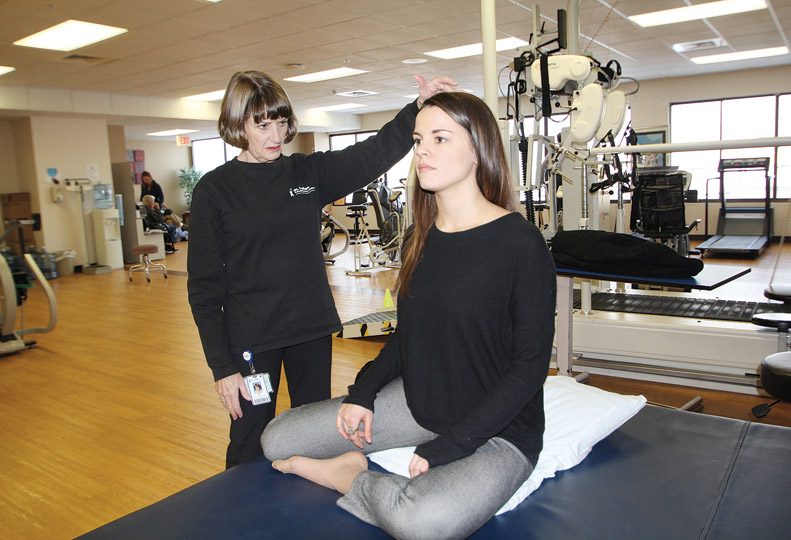
Home » St. Luke's increases role of Pilates in its rehab regimens
St. Luke's increases role of Pilates in its rehab regimens
Exercise method said well-suited for women

January 14, 2016
St. Luke’s Rehabilitation Institute, at 711 S. Cowley, has incorporated more Pilates-related training into rehabilitation regimens for patients in recent years.
St. Luke’s specializes in comprehensive inpatient and outpatient therapy sessions for children and adults and provides treatment for stroke, spinal cord injuries, orthopedic issues, and brain injuries. Pilates is a method of exercise that consists of low-impact flexibility and muscular strength and endurance movements.
Liz Gilbert, a certified Pilates instructor who St. Luke’s hired about six years ago to work with patients and to help train other employees to use Pilates when working with patients, says Pilates has benefits for everyone, but can be particularly helpful for women.
Women are more prone to creating their own “errors in movement strategy,” she says.
“A lot of women tend to be modest,” Gilbert says. Taller women might slouch trying to reduce their stature, while shorter women may spend more time wearing high heels trying to increase theirs. Women with larger breasts might hunch and round their shoulders, trying to conceal them as much as possible, she says.
One of the biggest culprits is uncomfortable shoes. Fashionable and stylish footwear often can cause women to suffer pain and physical ailments, says Gilbert, who has a master’s degree in health sciences and physical therapy and also co-owns Studio Pilates & Physical Therapy at 5915 S. Regal.
“We shuttle them into pretty shoes and treat our feet like they’re blocks,” she says.
As a child, Gilbert—who is 69—says her mother purposefully bought shoes that were too small for her because she didn’t want her feet to grow too big.
“You want feet with dexterity,” Gilbert says. If you can stand barefoot and lift each big toe off the ground while keeping the four other toes planted on the floor then it’s a good sign a person has dexterity in their feet, she says.
The Pilates Method Alliance, based in North Bay Village, Fla., has a national certification test and has been attempting to standardize Pilates training and competence across the country. Gilbert completed the PMA’s certification test last year.
Gilbert earned what’s called a Polestar Pilates certification, pertaining to a particular type of Pilates, almost three years ago. She says more common Pilates methods, like Stott and Barre, aren’t as applicable as Polestar is in rehabilitation due to their more physically intensive nature.
The primary tenets of Pilates center on breathing, core muscle control, spine articulation, proper organization of the head, neck and shoulders, working to align extremities, and movement integration.
Polestar Pilates was founded in 1992 by Dr. Brent D. Anderson and Elizabeth Larkin. Using common Pilates principles that had evolved over time, they added more biomechanics and motor learning into their instruction.
Anderson and Larkin are based in Coral Gables, Fla. Gilbert says the Polestar Pilates training was a year-long endeavor with 400 hours of self-practice, 100 hours of teaching, and 40 hours of observation, ending with a written and practical test.
“You have an obligation to continue training and improving patient care,” Gilbert says. “I use Pilates treatment in every patient I see.”
St. Luke’s treats patients of all ages, ranging from grade school to people in their 80s, Gilbert says.
She says there are some basic things everyone can do in order to improve their structural alignment. To start, don’t sit too long.
“Our bodies are meant to move, not to sit and look at computer screens or smart phones all day,” she says.
Next, those who wear glasses should frequently check their prescriptions.
“This is a big one. I’ve had people come to me experiencing severe neck pain,” she says. “After a while I realize that they can’t see their computer screens either at work or home and are craning their necks in order to see. I don’t know how many patients I’ve seen through the years who got new glasses or contacts and had their neck pain go away.”
Gilbert also urges caution to those who are members of fitness clubs where she says there is often too much of an emphasis on building muscle.
“I would say I probably see 90 percent of training and instruction in clubs done incorrectly,” she says. “The weight lifting is too fast and too much weight is being used. The healthiest goal is to have a lithe body rather than a muscle-bound body.”
And not just weight lifting, she says she has often seen improper teaching techniques applied in yoga and Pilates at fitness clubs.
“We treat a lot of people who have experienced injuries at their gym. Pilates should not be hurting anybody. It’s a slow and steady process,” Gilbert says. “If it’s done properly your body will naturally respond and correct itself.”
Latest News Up Close Health Care
Related Articles
Related Products



